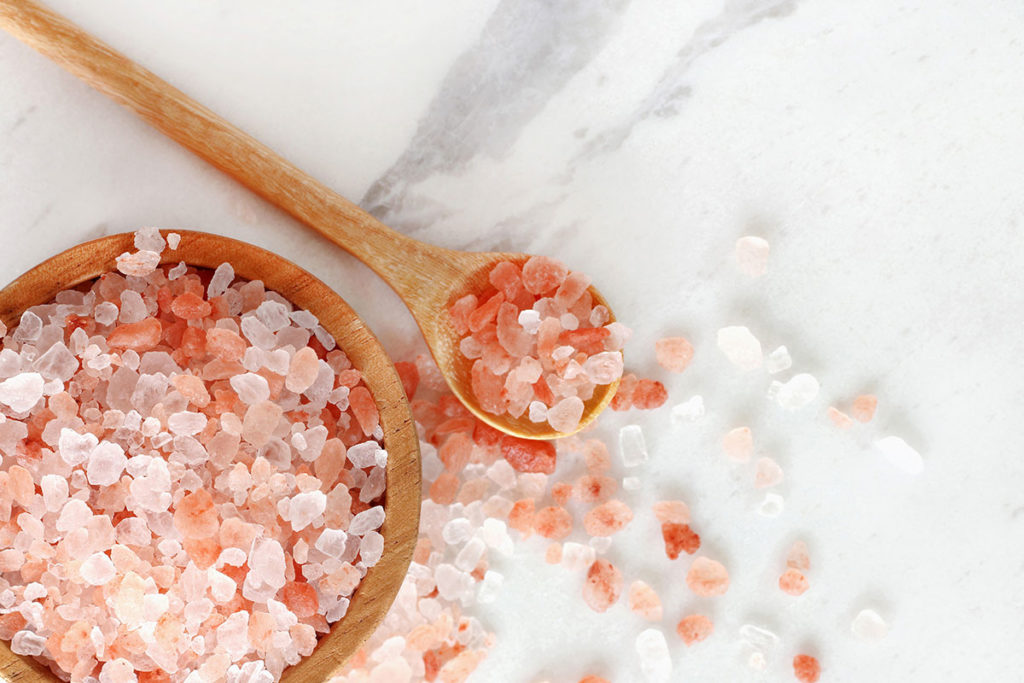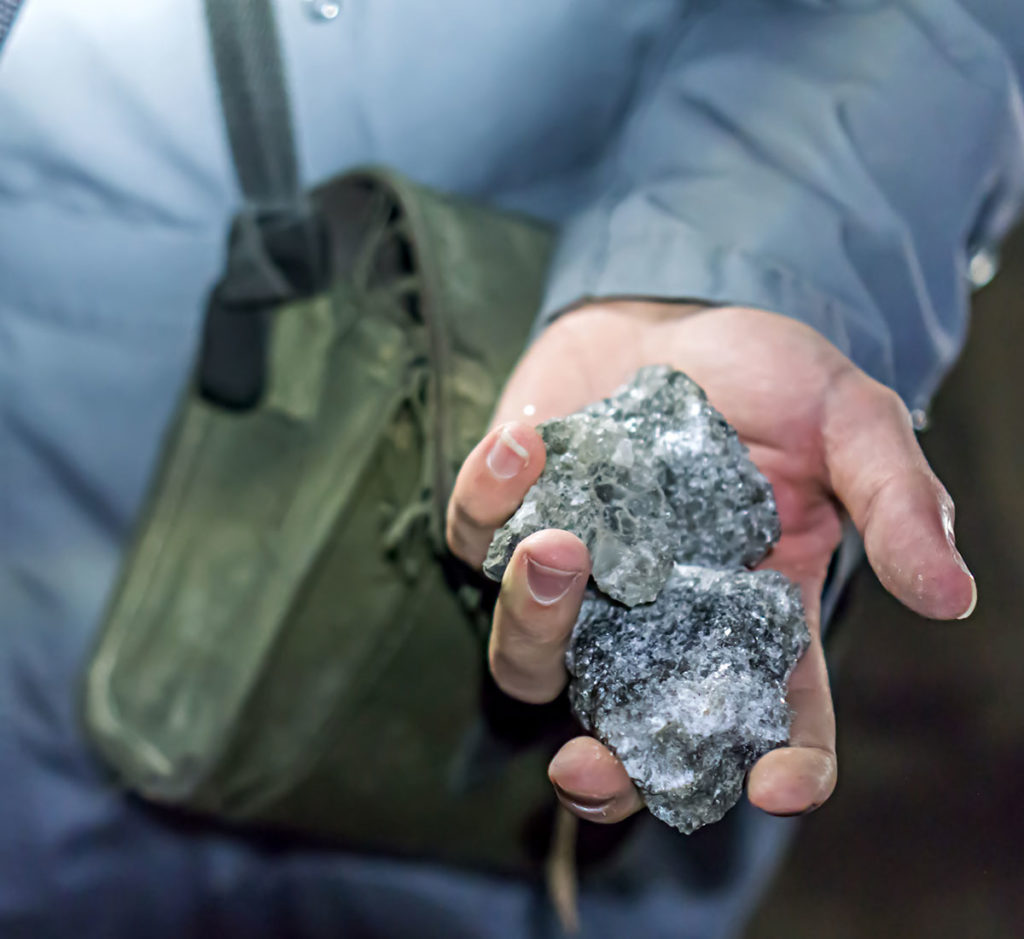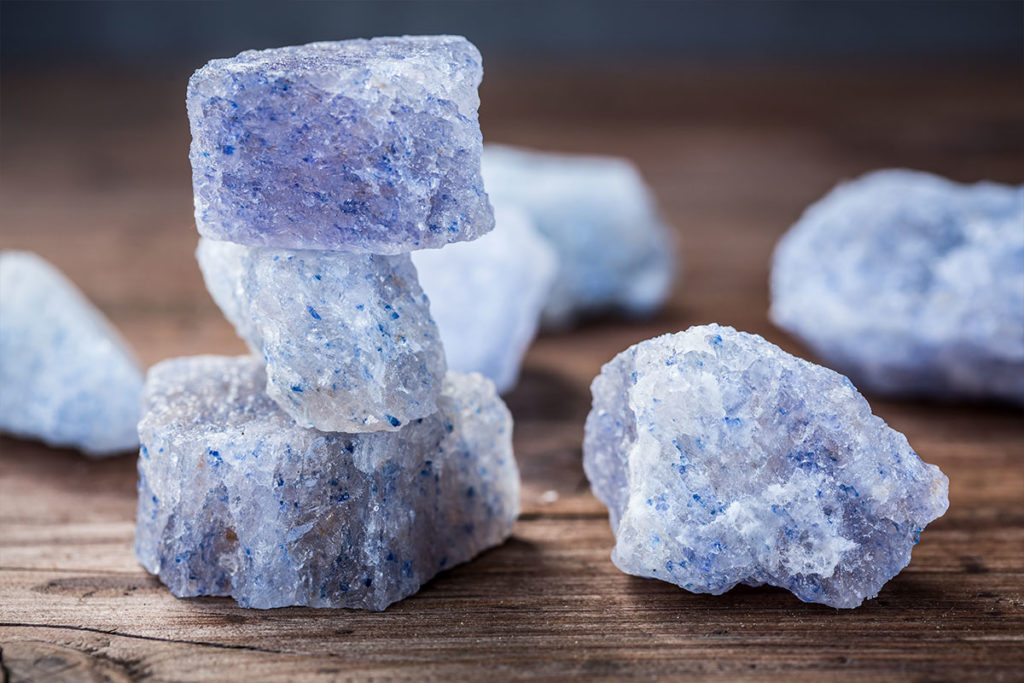Rock salt
From fine to coarse salt, white or blue, iodised or natural – as a leading wholesaler for salt products we offer a wide range of rock salt in top organic quality. Whether in large quantities starting from 25 kilograms or in household packaging, order the right rock salt for your needs from August Töpfer & Co. – the specialist for salt products.

What is rock salt?
Due to its age and compact crystalline quality, rock salt is considered an ancient, natural form of salt. Rock salt concerns an evaporite and sediment that forms in rock as a result of continental movements over millions of years. It is indeed an ancient salt – the evaporated remains of sea salt from past oceans. Rock salt occurs underground in layers of salt rock and primarily consists of the mineral halite. The salt bound in the earth’s salt deposits is obtained through mining. According to current levels of consumption per capita, the reserves should last another 400,000 years. This makes it one of few resources that are virtually inexhaustible, which we are proud to offer in top organic quality in the August Töpfer & Co. range.
How does rock salt form?
The formation of rock salt reveals a lot about the history of our planet. Even today, the continental plates are still in motion and the world’s oceans are by no means here for eternity. Our planet changed substantially over millions of years back when volcanic activity was more common. Rock salt formed through a slow process of geological displacement, seawater evaporation and changes in sea level. Over time, seas were cut off from their tributaries, drying out into vast layers of salt. The crusts made from Sea salt sank into deeper layers of rock as a result of sedimentation and transformed into halite crystals as a result of further evaporation and the effects of pressure. Halite crystals are an evaporite that forms from solutions containing sodium chloride, such as seawater, through evaporation and crystallisation processes. Today, rock salt is primarily found underground in the form of salt domes, salt pillows and marginal depressions.
Rock salt – contents and properties
Rock salt is a mono-mineral rock and is found in halite deposits deep in the earth. Halite is 98 percent sodium chloride, but crystallised rock salt also contains other valuable minerals and trace elements like calcium, phosphorous, magnesium and potassium chloride due to the sedimentation process. Small quantities of gypsum, anhydrite or sylvite can be bound into halite salt domes. The quality of rock salt in its natural form is coarse and crystalline. Pure rock salt is white but it can also exhibit colour tones due to the inclusion and mixing of minerals in the halite. These colours can range from white and yellow to red and black.
Each colour indicates substances present in the halite. Red is a sign of iron oxide, blue suggests sodium and colours from grey to black indicate carbon and bitumen. Natural and unrefined rock salt crystals are cubic and coarse; they are also available on the market in this form as a highly prized natural salt. The qualities of rock salt and halite include the intense salty taste and milky to transparent white colouring of the crystals. Due to the minerals contained in rock salt, rock salt is believed to have bio-energetic and healing health benefits in traditional medicine.
Rock salt – production and extraction
Most rock salt today is mined underground. It is extracted in salt mines that have been part of human history for over 7,000 years. There are currently seven active salt mines in Germany. The salt is obtained through either dry or wet mining. In wet mining, the salt dome is drilled and freshwater is pumped into the rock. The resulting aqueous salt brine is then evaporated in a salt evaporating plant into Evaporated salt .
Natural rock salt, by contrast, is extracted through dry mining using machines. Drilling and detonations release blocks from the layer of salt rock. The hollow spaces or chambers are braced by natural supports made from salt rock. In most cases, mining is conducted in tunnels accessible by vehicles. Drilling and detonations are controlled by computer. The broken material is transported to the crushing plant by loaders or conveyor belts and then to the earth’s surface.

Depending on the degree of purity, the rock salt can be sold as natural salt after crushing and filtering into the desired degree of granulation. Often, however, chemical cleaning and refinement processes are required to remove residues from the rock salt. For instance, this is necessary for producing table salt free from all minerals and trace elements, consisting of pure sodium chloride. Rock salt obtained from dry or wet mining forms the basis for around 70 percent of table salt worldwide.
The remaining proportion is made from sea salt. Since the daily salt requirements of the human body is very low – between three to six grams per day to be precise – most rock salt is actually used in industry for a wide range of purposes. For example, it is used as water softener, thawing salt or industrial salt. However, 85 percent of the mined rock salt serves as the raw material for the production of chlorine and sodium.
Rock salt – use as table salt
Rock salt has an intensely clear, salty taste. In particular, rock salt extracted from traditional mining is very popular due to its purity. After all, rock salt obtained from mining without additional industrial cleaning usually has a salt content of 98 percent. This makes rock salt ideal for cooking and baking for anyone who wishes to work or season with natural ingredients.
Whether in large rock salt quantities of 25 kilograms or in household packaging sizes: August Töpfer & Co. offers the right rock salt in suitable quantities according to your preferences. Depending on the degree of granulation, purity and colour, you can choose between untreated rock salt for use as table salt or refined rock salt that has been processed into table salt through cleaning and grinding.
Himalayan salt
As the name suggests, the precious and high-quality Himalayan salt is mined near the Himalayas in the highlands of Punjab in Pakistan. This is a coarsely ground salt with a distinctive pink colour and, like other rock salts, contains up to 98 percent sodium chloride and other trace elements and minerals like gypsum, sulphates and potassium chloride. It tastes very similar to conventional salt.

Blue salt
Blue salt is also known as Persian salt; it occurs in nature only rarely and is considered a highly coveted rock salt. It has a very intense, salty and tingling flavour and a distinct blue hue which it gets from potassium chloride. Since the salt seams of blue salt are very deep, like veins of gold, it is laboriously extracted in the northern Iranian province of Senman and only in relatively limited quantities. It is primarily used as a seasoning or condiment before consuming meals.
How healthy is rock salt?
Although rock salt is considered particularly healthy compared to conventional table salt due to the minerals and trace elements it contains, its health benefits can scarcely be distinguished from other types of salt. Whether consuming rock salt, sea salt or evaporated salt – what really matters is the recommended essential daily intake of salt of three to six grams. Too much or too little salt causes damage to the human body in the long run. Ultimately, the choice of salt is a matter of taste.
What else is rock salt used for?
Rock salt is not only used in food, but also has a number of other everyday applications. In fact, 85 percent of the rock salt mined worldwide doesn’t even end up in the kitchen, but is supplied to industry. Rock salt is the raw material for the production of chlorine and sodium, for example, which in turn are important for making chemical products like caustic soda and PVC plastic. It is also used as water softener, grit salt and as a salt glaze in traditional ceramic production.
